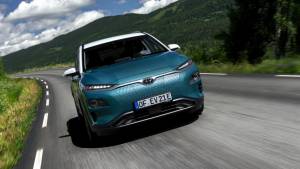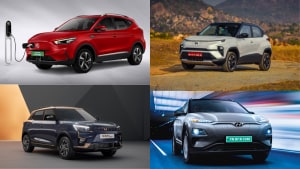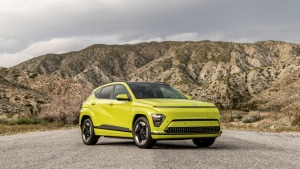2019 Hyundai Kona electric first drive review
Range anxiety and a substantial lack of charging infrastructure have been two of the biggest deterrents for those wanting to buy electric cars in our country. Of course, the fact that there aren't too many choices is yet another stumbling block. But Hyundai made quite a bold statement at the 2018 Auto Expo when it announced that it will launch an all-electric SUV in India in 2019 and the Korean car maker is living up to its word. Come July 09 and the Hyundai Kona electric SUV will go on sale in the country. But before that happens, we've managed to get a little taste of the Kona electric in Seoul, South Korea where the Hyundai Motor Company is headquartered. First things first, the Kona electric you see here isn't the exact spec that will come to India. This is the Korean version with all the bells and gongs you expect of a modern-day electric car.
 The Hyundai Kona electric will be launched in India on July 09 2019, making it the first ever all-electric SUV in the country
The Hyundai Kona electric will be launched in India on July 09 2019, making it the first ever all-electric SUV in the country
What really impressed me about the Kona electric at first glance though is the design. It does not look quirky in fact it looks sharp and has the muscular appeal that typical SUV buyers dig. The face looks distinct, for two particular reasons. First is the headlamp design, as the slim LED units look eye-catching. Secondly, considering that this is the electric version, Hyundai has done away with the grille and what you get instead is a plastic panel that resembles the grille thanks to its indentations. That is the only quirk visually, apart from which the Kona electric looks pretty regular. The 'grille' houses a flap which opens to reveal the charging port. Positioning the charging port into the front of the SUV means Hyundai has eliminated the need to reverse the Kona electric into tight spaces to charge it, as is the case with several EVs that have the charging port tucked into what is the fuel filler flap in conventional cars.
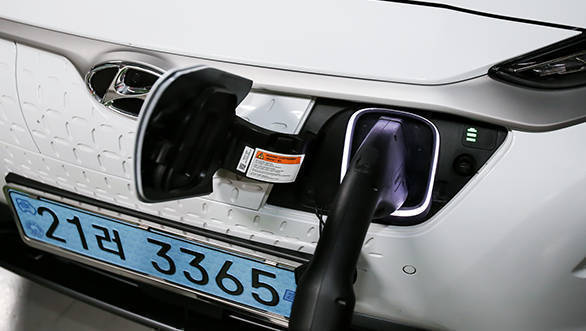 The charging port on the Hyundai Kona electric sits hidden under a flap on the front 'grille'
The charging port on the Hyundai Kona electric sits hidden under a flap on the front 'grille'
Another distinct giveaway about this being the electric version is the alloy wheel design. The black plastic cladding on the sides makes for a rugged appearance thereby lending the Kona electric a proper SUV stance, aided by the 2,600mm wheelbase which has allowed Hyundai to package the battery packs into the floorboard neatly. The rear looks arresting thanks to the edgy design and I also like the roof-mounted spoiler. Of course, the ultimate giveaway about this being an EV is the 'electric' badge at the rear. Overall, the Kona electric looks sporty and premium, while build quality is top notch.
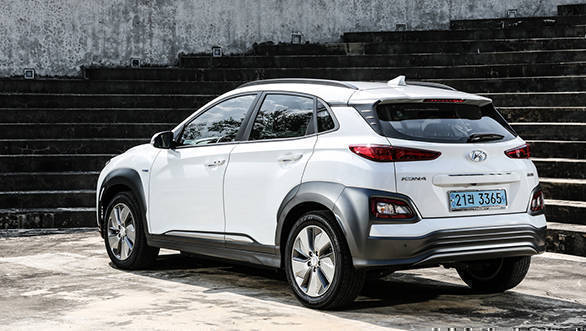 The Hyundai Kona electric looks pretty conventional as Hyundai first created the Kona SUV powered by petrol and diesel engines, so thankfully, its electric version does not look quirky like several other electric cars in the world
The Hyundai Kona electric looks pretty conventional as Hyundai first created the Kona SUV powered by petrol and diesel engines, so thankfully, its electric version does not look quirky like several other electric cars in the world
Moving onto the powertrain, Hyundai offers the Kona electric with two battery ratings internationally. One uses a 39.2kWh battery pack that powers a 134PS and 395Nm electric motor, while the more powerful version uses a 64kWh battery pack and the outputs for its motor are 204PS and 395Nm! Just to remind you, the latter's outputs are comparable to a whole lot of luxury SUVs. Then there's the range claimed at 450km under the WLTP which will blow your range anxiety to bits. Effectively, in theory, you are looking at a range of around 300km on a single charge. In fact, when I got behind the wheel, the instrument cluster displayed a range of over 400km, which had me stumped, as that's good enough for almost a week of commuting! More importantly, with a fast charger at hand, you can recharge the battery pack to 80 percent in just under an hour.
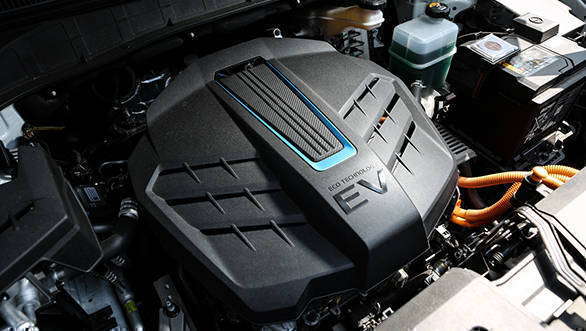 The Hyundai Kona electric is on offer in two states of tune internationally - one is powered by a 39kWh battery pack while the other is more powerful and uses a 64kWh battery pack
The Hyundai Kona electric is on offer in two states of tune internationally - one is powered by a 39kWh battery pack while the other is more powerful and uses a 64kWh battery pack
We only drove the 64kWh version though Hyundai is only launching the 39kWh version in India. The Kona electric is a front-wheel drive SUV and the motor sitting under the hood is a permanent magnet synchronous motor. Driving modes allow you to customise power delivery and while Eco mode is expectedly a little drab, Comfort mode does its job well. I switched to Sport and the difference was apparent instantly as the amount of wheel spin surprised me pleasantly not just when taking off from standstill but also on the go! A hard press on the throttle around corners had the front tyres chirp instantly accompanied by seriously quick acceleration, which isn't something I was anticipating. Around corners is also where I found that the weighted feel from the steering wheel was likeable, though some more feedback would have been welcome. However the steering did feel good when switching lanes quickly.
The combination of the steering feel and strong punch from the motor, literally from the word go, allowed me to make rapid progress through the light traffic on the open motorways on the outskirts of Seoul, only for the in-dash navigation to start beeping to remind I was over the stipulated 90kmph speed limit. Getting to triple digit speeds is easy and in fact at times the punch was so strong, I was stunned by the effortless acceleration and I couldn't help but break into a smile! Of course, I did miss the theatrics of an internal combustion engine, but to its credit, accelerate hard and the Kona EV rewards you with a whine that sounds sporty. There's a bit of road noise on the go, but it never gets too much.
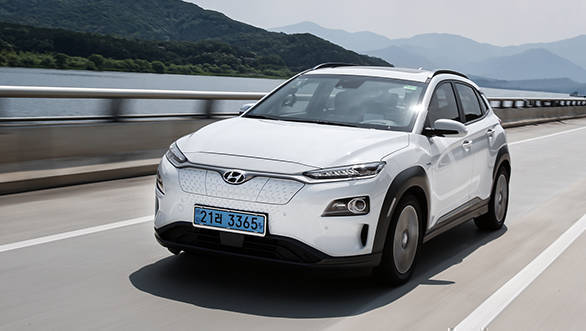 Straightline acceleration in the 64kWh version of the Hyundai Kona electric is very impressive thanks to the instant surge of torque from the electric motor
Straightline acceleration in the 64kWh version of the Hyundai Kona electric is very impressive thanks to the instant surge of torque from the electric motor
Another bit I really liked is that the Kona EV is equipped with paddles behind the steering wheel which allow you to choose from three levels of regenerative braking or simply turn it off. The highest level offers strong 'engine' braking and the moment you take your foot off the throttle the car starts slowing down very quickly, almost as if you are braking. You can also bring the Kona EV to a stop by simply holding onto the left paddle, using it as a brake. Another advantage of using more regenerative braking is that you use the brakes a lot lesser, which means lesser brake wear. Brakes offer good bite, though I would have liked more feedback. Roads in South Korea are pretty smooth so it was difficult to get a feel of the ride quality but with that said, the heavy batteries and firmness of the independent suspension all round meant expansion joints and the like were felt inside the cabin.
The Korean-spec Kona electric is also well-specced. There's everything you expect in a modern car, including a heads-up display! Interiors look good but more importantly they don't have the quirkiness of several other electric cars and. A large, 8 inch touchscreen display sits on top of the dashboard while a large circular display for the speedometer takes centre stage in the instrument binnacle. The interiors have a plush, upmarket feel while the centre console feels spacious and airy as Hyundai has done away with the drive selector 'stick'. There's a set of buttons instead for selecting drive modes. The Korean-spec Kona electric also gets ventilated front seats with heating and cooling functions both, along with an electric sunroof. The infotainment system offers Apple CarPlay and Android Auto connectivity and navigation as well.
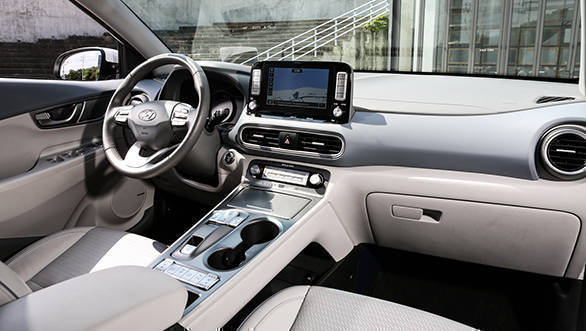 The Korean-spec Hyundai Kona electric boasts high equipment levels and an extensive feature list, while the interiors look conventional, just like regular cars
The Korean-spec Hyundai Kona electric boasts high equipment levels and an extensive feature list, while the interiors look conventional, just like regular cars
The Korean-spec Kona electric also gets niceties like Lane Follow Assist which keeps the car centered in your lane apart from Smart Cruise Control, collision avoidance and more though these could be omitted for India to keep costs in check. In terms of space, the front seats are spacious and comfortable while rear seat space is in line with what we are used to seeing in compact SUVs. The Kona electric will thus be comfortable for four, though you should be able to squeeze a third person at the rear in a pinch. Taller occupants might find kneeroom at the rear to be constrained though. Boot space is adequate as well. Hyundai will offer the Kona with a domestic charger at no extra cost in India, apart from which Hyundai dealerships selling the Kona electric (only dealerships in select cities will offer it) will also allow you to charge it via fast chargers. A standard charger will recharge the 64kWh battery pack in about 8 to 10 hours. You could plug in the standard charging cable into the 220V socket at home too, but that will take a lot longer.
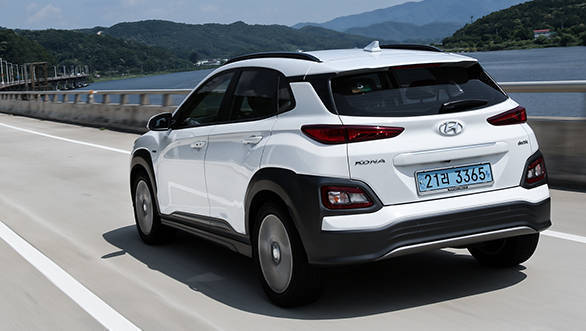 The Hyundai Kona electric is sure generate a lot of interest with its packaging, performance and equipment levels
The Hyundai Kona electric is sure generate a lot of interest with its packaging, performance and equipment levels
On the whole, I would have liked more seat time in the Kona electric, as the e-SUV has intrigued me a lot. I am seriously impressed with its performance, the 'normal' feel as also overall dynamics. The styling rounds off its packaging pretty well and I have to say, the Kona electric is a very interesting prospect. Contrary to my expectations it surprised me in many ways and pleasantly at that. Hyundai will assemble the Kona electric in India, as the CKD route will ensure import duties and taxes aren't sky high. It is expected to be priced around Rs 25 lakh ex-showroom which sounds about right, though it will be interesting to see how the Indian version is specced. Another challenge here will be charging infrastructure, or rather the lack of it, though Hyundai is positive about the scenario changing rapidly once EV-adoption gains pace. The fact that Hyundai isn't really eyeing large volumes with the Kona is a given, but with its packaging, performance and dynamics, this electric SUV is sure to generate serious amounts of interest and also make several other manufacturers sit up and take notice of the EV space.
Also Read,
Hyundai Kona all-electric crossover gets listed on the manufacturer's Indian website
Also Watch,
Also see: Hyundai Kona Electric First Drive Video
Starts Rs 23.72 Lakhs
-NA-
Automatic
136
395
-NA-
